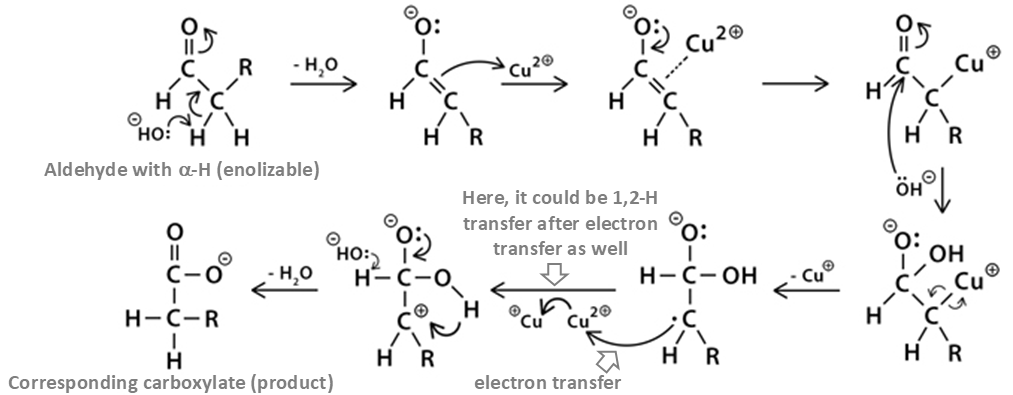As noted in your post, aldehydes can be very easily oxidized and hence considered as strong reducing agents (Ref. 1). Fehling's reagent is a weak oxidizing agent, which requires strong reaction conditions such as heating the reaction mixture to boiling $(\approx \pu{100 ^\circ C})$. This oxidation process is complicated, one of such reliable mechanism is illustrated in following image:

Accordingly, it's not certain Fehling's test may or may not required aldehydes with presence of enolizable hydrogen(s) $(\alpha-\ce{H})$ (the mechanism certainly shows it needed). If so, that makes it difficult to avoid side reactions such as aldol condensation because strong alkaline solutions are in use. That's the reason Ref. 2 (Daniels, et al. 1960 in the excerpt posted in the question) have given three categories for positive and negative results of Fehling's test on regular aldehydes (specifically see second category):
(1) A colorless aqueous solution admixed with a yellow to red precipitate results. The precipitate is $\ce{Cu2O}$; its formation represents a positive test.
(2) Complex changes occur, with formation of a red or dark-brown, gummy precipitate. In this case, the supernatant liquid may be blue, green, brown, yellow, or orange.$^3$ Nevertheless, this constitutes a negative test because experiments in our laboratory indicate that the precipitate is not copper(I) oxide. Apparently these changes have been mistaken for a positive test.
(3) The blue solution of the test reagent remains, with or without the presence of a colorless immiscible organic layer. This is a negative test. We subjected several aldehydes and ketones to these tests and found that carbonyl compounds could be classified according to the color changes described above
Category (1): glucose and the reducing sugars, a-hydroxy ad ip-aldehyde, glyoxal, and pyruvic aldehyde.
Category (2): acetaldehyde, crotonaldchyde, cinnamaldehyde, and aldol.
Category (3): benzaldehyde and aromatic aldehydes in general, isobutyraldehyde, 2-ethyl-hexanol, and acetone.
$^3$ It is noteworthy that the Fehling test solution gives rise to more extensive changes than does the Benedict test solution. In the case of the Fehling test, a trace of copper (I) oxide may be formed if an excess of test compound is employed.
However, Ref.2 conclude following for certain by their preliminary results of wide variety of aldehydes and ketones:
Copper(II) ion in Fehling or Benedict test solution will be reduced to copper(I) oxide by $\alpha$-hydroxyaldehydes, $\alpha$-hydroxy ketones and $\alpha$-ketoaldehydes. Other aldehydes and ketones do not produce copper(I) oxide.
As mentioned in Ref. 1, the authors of Ref. 2 have found that the Tollens’ test reagent is "infallible" for distinguishing aldehydes from ketones.
Also keep in mind that all reducing sugars are $\alpha$-hydroxyaldehydes, which fall in to above conclusion.
References:
- I. L. Finar, Organic Chemistry, Volume I: The Fundamental Principles; Fourth Edition, Longmans, Green & Co. Ltd.: London, United Kingdom, 1963, page 160 (ISBN-13 for 1973 print: 978-0-582-25166-3).
- Ralph Daniels, Clyde C. Rush, and Ludwig Bauer, “Textbook Errors 24: The Fehling and Benedict tests,” J. Chem. Educ. 1960, 37(4), 205-205 (DOI: https://doi.org/10.1021/ed037p205)


